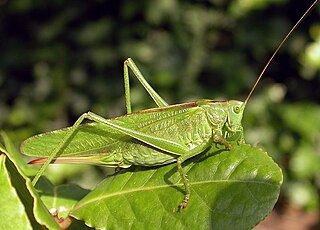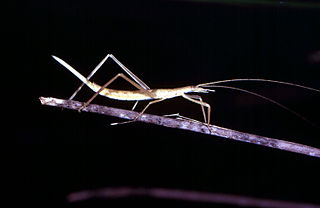
Insects in the family Tettigoniidae are commonly called katydids, or bush crickets. They have previously been known as "long-horned grasshoppers". More than 6,400 species are known. Part of the suborder Ensifera, the Tettigoniidae are the only extant (living) family in the superfamily Tettigonioidea.

The Tettigoniinae are a subfamily of bush crickets or katydids, which contains hundreds of species in about twelve tribes.
Aglaothorax is a genus of ovate shieldbacks in the family Tettigoniidae. There are about six described species in Aglaothorax.
Neduba extincta, the Antioch Dunes shieldback katydid, is an extinct species of katydid that was endemic to California, United States. It was not discovered until after its extinction.

Neduba is a genus of insects in the family Tettigoniidae (katydids), which is native to North America.
Phasmodes, known as stick katydids, is a genus of insects in the family Tettigoniidae and the only genus within the subfamily Phasmodinae. It contains the following species:

Mecopodinae, the long-legged katydids, are a subfamily of bush crickets found in western South America, sub-Saharan Africa, and Asia. In Asia, the distribution includes India, Indochina, Japan, the Philippines, and Malesia to Papua New Guinea and Australasia, including many Pacific islands.

Conocephalinae, meaning "conical head", is an Orthopteran subfamily in the family Tettigoniidae.

Agraeciini is a large tribe of bush crickets or katydids in the conehead subfamily, Conocephalinae.

Zaprochilinae is a subfamily of bush-crickets found in Australia.

Austrosaginae, the sluggish katydids, are a subfamily of Australian insects within the family Tettigoniidae.

Tettigoniidea is an infraorder of the order Orthoptera, with six extant families.

Capnobotes is a North-American genus of shield-backed katydids in the family Tettigoniidae. There are about 9 described species in Capnobotes.
Aglaothorax ovata, the ovate shieldback, is a species of shield-backed katydid in the family Tettigoniidae. It is found in North America.
Eremopedes is a genus of shield-backed katydids in the family Tettigoniidae. There are about 16 described species in Eremopedes.
Idionotus is a genus of shield-backed katydids in the family Tettigoniidae. There are about seven described species in Idionotus.
Decticita is a genus of shield-backed katydids in the family Tettigoniidae. There are at least three described species in Decticita.
Aglaothorax diminutiva, the diminutive shieldback, is a species of shield-backed katydid in the family Tettigoniidae. It is found in North America.
Aglaothorax morsei, or Morse's shieldback, is a species of shield-backed katydid in the family Tettigoniidae. It is found in North America.

Chlorobalius leucoviridis, commonly known as the spotted predatory katydid, is a species of long-horned grasshopper in the family Tettigoniidae. It is a predator and is an acoustic aggressive mimic of cicadas; by imitating the sounds and movements made by female cicadas, it lures male cicadas to within its reach and then eats them.











